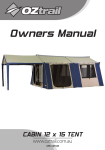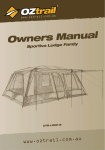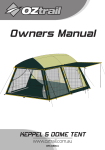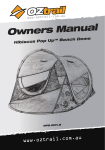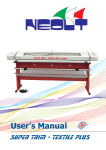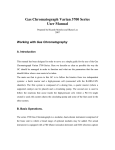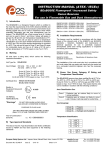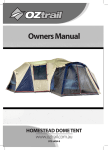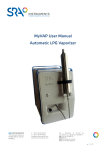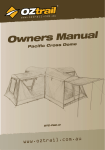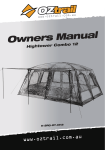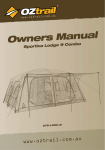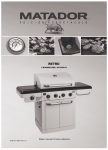Download Owners Manual
Transcript
Owners Manual SPORTIVA LODGE www.oztrail.com.au DTS-LOD-B 1 IMPORTANT SAFETY AND CARE INFORMATION To prevent injury caused by fire - PLEASE READ BEFORE SETTING UP YOUR TENT/SHELTER • Do not pitch the tent/shelter near a camp fire or any other flame source • Do not use candles, matches or any other flame source in or near the tent (this includes stoves, cooking equipment, lighting and heating appliances) • Only use recommended water repellent compounds on the tent/shelter fly • Do not spray tent fabrics with insecticides At the time of purchase we guarantee that this product is supplied without fault in construction, materials or function. We recommend that you assemble it as a trial before going away. If problems are discovered in the brand new product, they will be dealt with under our warranty. • This product is designed as a portable and temporary structure; it is not designed to be a permanent structure or dwelling. • Intermittent use only. Although our polyester fabrics are treated for extra UV resistance, continuous exposure to sun light will break the fabric down. Fading of colour is an early warning sign. These tents/shelters are not designed as permanent dwellings or structures. • Do not leave this product unattended if bad weather is expected. If assembly instructions are followed correctly, this product will withstand mild winds and rain. In gusty winds and storms you must collapse the tent/shelter. • We recommend that you discuss adding this investment to your household Insurance Policy with your Insurance Agent. CAMP SAFE - SAFETY HABITS The fabric may burn if left in continuous contact with a flame from any source. Also, the application of any foreign substance to the tent fabric may render the flame resistant properties ineffective. To prevent injury caused by gas poisoning or suffocation • Do not use fuel burning, oxygen consuming devices inside the tent. This includes candles, gas lanterns, kerosene lamps, stoves, cooking and heating appliances • Do not use gas appliances of any kind inside the tent/shelter To prevent injury caused by electricity • Always exercise care when using electricity and electric lighting in and near tents/shelters. Only use 12 volt lighting. To prevent injury caused by your camping environment - 5 4 3 2 1 • Do not pitch your tent/shelter on an area that could get flooded • Do not leave your tent/shelter erected in strong winds collapse the tent onto the ground and seek refuge in your vehicle • Do not pitch your tent/shelter near cliffs in case of collapse or rock fall • Do not pitch your tent/shelter under trees with dead branches or under trees known to drop branches EXTREME CAUTION - Gas or fumes or lack of oxygen within the tent/shelter could result in unconsciousness, brain damage and even death 2 3 Product Code ~ DTS-LOD-B PRODUCT AND PARTS Thank you for purchasing a superior OZtrail product. Please keep this Owners Manual in a safe and dry place, it contains important and helpful information. IMPORTANT We recommend that you set up this product before you leave for your trip. Check that all parts are present and that you familiarise yourself with the assembly and disassembly of the product. If you have any problems, your OZtrail dealer will be able to sort it out for you. You should have the following parts: Product Code ~ DTS-LOD-B 2 x Corner to Corner Roof Portico Poles – Long length of fibreglass poles with burgundy colour tape 2 x Side to Side Roof Portico Poles – Short length of fibreglass poles with navy colour tape 2 x Side Halo Poles – Length of fibreglass poles with bent ferules and tips on the two ends 3 x Steel Awning Poles, silver in colour 1 x Gear Loft 2 x Cup Holders 1 x Peg Bag with Steel Pegs Part Description 1 x Tent Inner 1 x Tent Fly 4 x Corner Portico Hubs (attached to the Tent Inner) 2 x Side Portico Hubs (attached to the Tent Inner) 4 x Corner Portico Poles – Long length of black steel poles with no colour tape 2 x Middle Portico Poles – Short length of black steel poles with no colour tape 2 x Roof Reinforcing Poles – Black steel poles with yellow tape PLEASE NOTE - Due to our policy of continual product development, specifications and features of the product may vary from details within this Owners Manual. 4 5 ASSEMBLY INSTRUCTIONS ASSEMBLY INSTRUCTIONS Step 1 - Select the site It must be: ~ level, sheltered, free of roots, sticks and rocks and well drained. Remove the contents from the storage bag. Finally, select the 2 black steel ‘Roof Reinforcement Poles’. These are placed into the Portico hubs located on the corners of the tent. These poles span between each hub along the shortest side of the tent. The correct hub insertion points will be marked with yellow tape. Connect the corresponding poles clips on the inner tent to these poles. Step 2 - Peg out the tent. Lay out the tent inner on the area where you wish to erect your tent. Ensure that you have the doors facing in the direction you desire. Select 7 steel pegs from your peg bag. Peg out the inner of your tent at the 7 peg points of your inner tent. These peg points are indicated in Figure 1. Do not peg the tent too taught, it must be flat but not under any stress. You can always add more tension later, once the tent is erected. Step 5 – Attaching the tent’s Portico Legs Utilising the help of at least one other person: Select the 4 black steel ‘Corner Portico Poles’. Place one into each corner Portico hub and the opposite end of each pole into the ring and pin assembly at the base of the tent corner. Attach the pole clips located on the inner tent to the pole. Select the 2 black steel ‘Middle Portico Poles’. Place each into its middle Portico hub and the opposite end of the pole into the ring and pin assembly located at the base of the tent. Attach the pole clips located on the inner tent to the pole. Hint: Before attempting this step it helps to open the doors of the tent. This allows for the air to rush in much faster to your tent when you begin raising it from the ground. This Oztrail Sportiva Tent is Tent Power System compatible. You can install, the leads and slot the end fitting through the Port in the roof of the inner tent before the next step. Step 3 - Assemble the poles Lay out all of your poles. Ensure that you have identified what each pole is for. Do not stand, sit on or drive over the poles! Step 4 - Assemble the Portico Roof Select the 2 ‘Corner to Corner Roof Portico Poles’, they have the burgundy tape. Inset the poles diagonally from one corner of the tent roof to the other. Ensure that the pole passes through the pole sleeves with the burgundy trim. Insert the end of each pole into the corner Portico hubs attached to the inner tent. The correct insertion point will be shown with corresponding burgundy tape. Connect the pole corresponding clips on the inner tent to the poles to these poles. Once the ‘Corner to Corner Roof Portico Poles’ are in place select the 2 ‘Side to Side Portico Roof Poles’ that are marked with the navy coloured tape. Insert the poles through the corresponding pole sleeves, marked with navy tape, from one side of the tent roof to the other. Ensure that these poles cross under the 2 ‘Corner to Corner Roof Portico Poles’. Place the ends of these poles into the Portico Hubs located at the middle of the tent’s roofline. The correct insertion point will be shown with corresponding navy coloured tape. Connect all of the corresponding pole clips on the inner tent to these poles IMPORTANT After unpacking the tent, use the check list on page 4 to make sure you have all the parts. 6 Step 6 – Attaching the Fly Sheet Select you tent’s fly sheet. With the aid of another person drape the fly sheet over the top of the now erected inner tent. Hint: It is far easier to start at the end of the tent and walk simultaneously along the longer sides of the tent, bringing the fly sheet along with you. Do this slowly to avoid snagging the tent fly and causing it damage. Once the tent’s Fly Sheet is draped over the tent ensure that is attached at the base of the 4 corners of the tent. Then attach all of the Velcro attachment points on the underside of the Fly Sheet to the corresponding poles and hubs. Hint: The Velcro attachment points are vital, ensure that you have all of these securely in place around their respective poles or hubs. Now that your Fly Sheet is secure you can place in your ‘Side Halo Poles’ across the shortest side of the Fly Sheet’s roof. There will be a pole sleeve on the underside of the Fly Sheet and a reinforced insertion point on the Inner Tent for the end tips of the pole. Once the pole is in place it should hold it position without constant reinforcement. Step 7 – Finishing Touches Now your tent is erected you need to ensure that it is secure. Ensure that all of the guy ropes are pegged out at approximately a 45 degree angle. Also check all of your peg points are pegged out and secure. 7 FIGURES AND ILLUSTRATIONS Figure 1 TO P V IE W FIGURES AND ILLUSTRATIONS REAR VI E W Peg Po i nt s i n d i c ate d by a r rows SE W N D IV ID ER 8 9 DISASSEMBLY INSTRUCTIONS Step 1 Release guy ropes. Release velcro that attaches the fly to the poles. Remove Portico poles. Remove fly from tent. Lay fly flat on ground and fold the fly in half, third or quarters. (folding depends on the length of the pole carry bag.) Step 2 Unzip doors and windows, collapse the tent by removing and disassembling the poles. FOLDING INSTRUCTIONS Important Do not store your tent away wet, damp or dirty. If you have no choice but to return home from your camping trip with a wet, damp or dirty tent, make sure you lay it out to air in a cool, dry and shaded place and only pack it away when it is completely dry and clean. Place the poles in the pole carry bag and tie shut. Step 3 Step 4 Step 5 Remove pegs. Do not remove pegs from the ground by pulling on peg loops. This may cause the peg loops to tear out of the seam. Spread the tent out flat with all loose fabric within the edges of the tent base. Try to flatten the tent as much as possible. Fold the tent in half, third or quarters. (folding depends on the length of the tent pole sections.) Place the folded fly in tent as you make the last fold. Step 6 Place the pole bag on back end of tent (trapped air is more easily forced out of the open door when you are rolling up the tent.) The folded tent should be the width of the pole bag. Step 7 Step 8 Figure 5 Fold t ent int o a Rect angular shape Beginning at the back end, roll your tent tightly around the pole bag, forcing out excess air as you roll. Keep tent edges straight and pole bag centred as you roll. When tent is rolled up, tie straps around it and place into tent carry bag with peg bag, instruction sheet, and other miscellaneous parts. If tent won’t fit into bag, unroll and reroll more tightly. Fr ont of t ent (door unzipped) The width of the tent should not exceed the length of the pole bag ROLL Do not remove pegs from the ground by pulling on peg loops. This may cause the peg loops to tear out of the seam. 10 11 PROLONGING THE LIFE OF YOUR TENT/SHELTER UNDERSTANDING WATERPROOFNESS • Intermittent use only. Although our polyester fabrics are treated for extra UV resistance, continuous exposure to sun light will break the fabric down. Fading of colour is an early warning sign. These tents/shelters are not designed as permanent dwellings or structures. • During rain always lower awnings to avoid water ponding and collapsing the awning. • If seam seal tape is lifting, simply cut the lifted tape off and apply seam sealer to the seam. • Never store a wet and/or soiled tent/shelter; as mildew and corrosion can form within a few days. This condition is not covered by the warranty. Always allow the tent to dry completely before packing and stowing. If mildew occurs, use a soft bristle brush or sponge with mild detergent to clean it off. • The elastic shock cord within the poles is provided for easy assembly of the poles. The shock cord is not required for any structural reason. The poles and tent perform perfectly well without the shock cord. Age, over stretching and mishandling may cause failure. Shock cord is not covered by warranty. It’s easy to replace, see instructions. • Sometimes the zipper coil bursts open or does not close. This could be due to wear or metal fatigue. The problem can be easily fixed, see instructions. • First aid for tears and ash burns is to carry a roll of tape, industrial or medical. This not only blocks the hole, it will prevent further tearing. It could have other uses around the camp site too. • When removing pegs, do not use the webbing or corner of the tent as your handle. Either use another peg, a peg remover or the claw of a hammer hooked under the peg to remove them. What is not covered by warranty! IMPORTANT - CONDITIONING YOUR NEW CANVAS TENT Once you get your new tent home, it is important to condition the tent. Simply pitch your tent and wet it down with your garden hose. Pay particular attention to the seams - the thread swells when wet and blocks the needle holes. The needle holes also shrink around the thread. The canvas fabric also benefits from this because the cotton swells into the weave and the waterproof treatment settles within the fabric. Let the tent dry completely before doing it a second time. Always pack your tent away dry. 12 OZtrail tents use waterproof and water repellent fabrics. However, with the addition of seams, zips and other desirable features a recreational tent will not be as waterproof as a car, house or other solid structures. The following are common examples of how water can enter a tent: Condensation - When warm moist air meets cooler air, condensation occurs. The tent/shelter fly forms an impermeable layer between the inside and outside conditions. The moisture inside the tent/shelter condenses on the fabric. Sometimes in cold conditions it appears that the fabric is leaking when in fact the cause is condensation. Condensation can be reduced if the tent/shelter is well ventilated. Seams - All seams are factory tape sealed but could leak at webbing and guy line entry points and where there is multiple layers of fabric. If leakage at these points becomes a problem, simply use a recommended seam sealant. For both canvas and polyester fabrics rubbing a candle on the seam is a quick and easy fix. Zips - All care is taken in the design to cover zips with rain flaps. At times wind driven rain could force water under the rain flaps and through the zips. To minimise this, make sure all doors and windows are closed with the rain flaps covering the zips. Floor - If the ground is very wet or water pools under the floor, downward pressure of standing or kneeling on the floor could force water through the floor fabric. To prevent this, do not pitch the tent over hollows and make sure water drains away from the tent. Structural Integrity - A perfectly pitched tent on perfectly flat ground is structurally strong and most waterproof. During prolonged periods of rain and wind it may be necessary to tighten guy lines and reset the tent pegs and attend to drainage around the tent. Sagging and incorrect pitching weakens the tent structure and could allow water to pool on the fly placing undue forces on the tent causing leaking and breakages. 13 Replacing shock-cord in tent poles ZIPS Use this procedure to replace broken or untied Shock-Cord:- Reducing the risk of jamming fabric in the zip ~ • When using the zip, hold the pull-tab between your thumb and forefinger with your thumb facing you. • As you are closing the zip clear the way in front and under the zip slider using the back of your hand, and cup the zip slider underneath with your remaining 3 fingers. 1. Start by cutting the Shock-Cord to 2/3’s the length of the Tent Pole 2. Feed the cord through the first pole section and tie a double knot. The knot will catch on the end of the fibreglass pole inside the ferrule. 3. Stretch the Shock-Cord through each Pole Section keeping the cord stretched within the poles so you have enough relaxed cord to feed through the next Pole Section. 4. Once all Pole Sections are threaded, double check that the Shock Cord tension is not either too loose or too tight and then tie-off the free end. Shock-cord can be purchased by the metre from Camping Stores or with Pole Repair Kits. Tent Pole Ferrule Knot tied in Shock-Cord Use this action for opening or closing. Keep the fabric clear of the zip slider - zip and unzip slowly. What to do when the zipper gets caught ~ • Pull the fabric bit by bit out of the slider. Do not try and pull all the fabric in one go. Do not force the slider, or use pliers on either the fabric or the zip. If the slider does not close the zipper properly ~ • With use, the jaws of the zip slider can open ever so slightly. When this occurs the slider does not compress the zip teeth or coil together tightly enough and the zip bursts open or does not close. • Undo the zip and with the slider at the end of the zip lightly crimp the jaws of the slider together. Try top to bottom axis first and then side to side axis. Crimping A Zip-Slider B Shock-Cord Pole Sections End Ferrule A C 14 The most common reason why zips burst open is that the zip slider does not close the coil tightly enough. Metal fatigue and production variances cause the gap marked A to open up. By simply ‘crimping” the slider together at points B & C with a pair of pliers, this solves the problem most of the time. Crimping in other planes is worth a try if B & C does not work. This is to be done when the zip slider is still attached to the zip in the open position. 15 WARRANTY We guarantee that the brand new product does not have faulty construction, materials, components or function. If a fault is discovered that existed in the brand new product within the first 12-months of use, we will replace or repair it at our discretion. Proof of purchase, including the purchase date will be required. Exceptions Fair wear and tear, damage caused by improper use, misuse or abuse. Commercial users are not covered by this warranty. Defects due to modification, accident, damage caused by vandalism, rusting, acts of nature or any other event beyond the control of the manufacturer. This warranty does not cover scratching, scuffing, natural breakdown of materials that occur inevitably with extended use including Ultra Violet light damage, exhausted zippers or other cosmetic damage that may result from normal wear and tear. In addition, defects resulting from intentional damage, negligence or unreasonable use will void the warranty. This warranty does not cover incidental expenses including property damage. 16 Imported by: OZtrail Leisure Products PO Box 1, Sumner Park QLD 4074 www.oztrail.com.au Made in China









